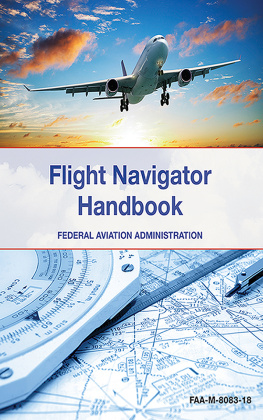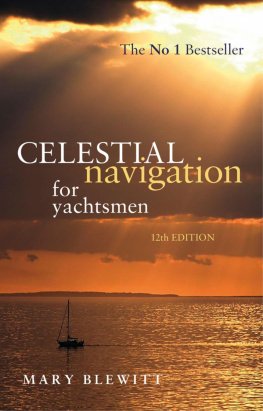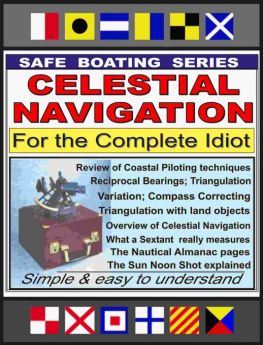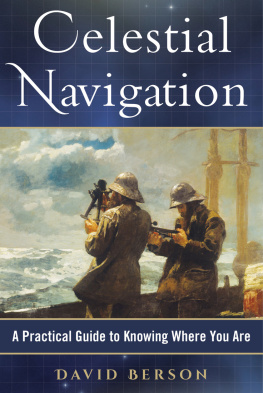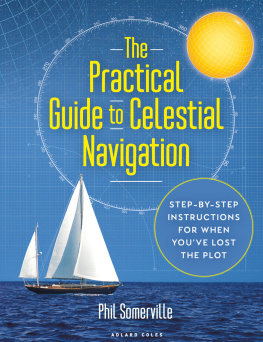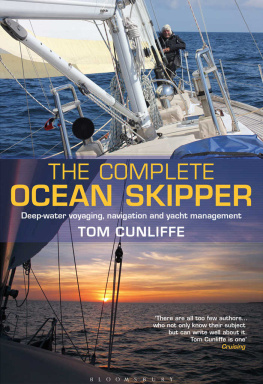Karl - Celestial Navigation in the GPS Age
Here you can read online Karl - Celestial Navigation in the GPS Age full text of the book (entire story) in english for free. Download pdf and epub, get meaning, cover and reviews about this ebook. year: 2012, publisher: Paradise Cay Publications, Inc., genre: Home and family. Description of the work, (preface) as well as reviews are available. Best literature library LitArk.com created for fans of good reading and offers a wide selection of genres:
Romance novel
Science fiction
Adventure
Detective
Science
History
Home and family
Prose
Art
Politics
Computer
Non-fiction
Religion
Business
Children
Humor
Choose a favorite category and find really read worthwhile books. Enjoy immersion in the world of imagination, feel the emotions of the characters or learn something new for yourself, make an fascinating discovery.

- Book:Celestial Navigation in the GPS Age
- Author:
- Publisher:Paradise Cay Publications, Inc.
- Genre:
- Year:2012
- Rating:4 / 5
- Favourites:Add to favourites
- Your mark:
- 80
- 1
- 2
- 3
- 4
- 5
Celestial Navigation in the GPS Age: summary, description and annotation
We offer to read an annotation, description, summary or preface (depends on what the author of the book "Celestial Navigation in the GPS Age" wrote himself). If you haven't found the necessary information about the book — write in the comments, we will try to find it.
Karl: author's other books
Who wrote Celestial Navigation in the GPS Age? Find out the surname, the name of the author of the book and a list of all author's works by series.
Celestial Navigation in the GPS Age — read online for free the complete book (whole text) full work
Below is the text of the book, divided by pages. System saving the place of the last page read, allows you to conveniently read the book "Celestial Navigation in the GPS Age" online for free, without having to search again every time where you left off. Put a bookmark, and you can go to the page where you finished reading at any time.
Font size:
Interval:
Bookmark:
CELESTIAL
NAVIGATION
IN THE GPS AGE
REVISED AND EXPANDED
John Karl
Copyright 2007, 2009, 2011 John H. Karl
All rights reserved. No part of this book may be used or reproduced in any manner whatsoever without written permission, except in the case of brief quotations embedded in critical articles and reviews. For information, contact the publisher.
Nautical Almanac data is reproduced with permission from Her Majesty's Nautical Almanac Office, CCLRC 2004. CCLRC is an abbreviation for Council for the Central Laboratory of the Research Councils, who own the copyright on the data.
No copyright claimed for sight reduction worksheets in , pages 277-283.
Cover design by Rob Johnson, www.johnsondesign.org
Editing and book design by Linda Morehouse, www.webuildbooks.com
Revised edition editing by Rebecca S. Bender
Painting on inside front cover, oil on canvas,
Captain Sumner Discovers the Celestial Line of Position by John H. Karl
Printed in the United States of America
First Edition, Third Printing
ISBN 978-0-939837-75-7
Published jointly by
Paradise Cay Publications, Inc. | Celestaire, Inc. |
P. O. Box 29 | 4609 E. Kellogg Drive |
Arcata, CA 95518-0029 | Wichita,KS 67218 |
+1-707-822-9063 | +1-316-686-9785 |
+1-707-822-9163 (Fax) | +1-316-686-8926 (Fax) |
www.paracay.com | www.celestaire.com |
info@celestaire.com | info@paracay.com |
To Karen, shipmate in life
Celestial navigation is seen today in a different light than before GPS became affordable and ubiquitous. Yes, it is the only manual way to navigate at sea (and one needs a manual way to do anything important at sea). But when celestial navigation was required, it seemed like work. Now it can be fun. It frees us from keys and menus that only serve to summon the expertise of some programmer and lets us do something by ourselveswith our own two hands.
Today's navigator needs not be an expert anymore, but should know enough to use celestial fixes as a backup. Of course he may take the study further, and therein lies the enticement. Celestial navigation is easy to start, but can take time and study to master. Activities like this have always held lasting fascination (some would say addiction) for us.
John Karl's book lets the reader proceed in this way. A line of position is put on a chart after only 40 pages. But then he will take you further in understanding the science and art of celestial navigation than any other book I have seen. Celestial Navigation in the GPS Age is a mixture of history, math, and rational explanations that the reader may sample as desired.
This may not be the only book to which you are exposed in learning celestial navigation, but it certainly should be one of them.
Kenneth Gebhart
Kenneth Gebhart is the author of the Celestaire Navigation Catalog. He is well known for his celestial navigation seminars given at most sailboat shows.
Browsing in a bookstore when I was about nine, I bought a book called American Practical Navigator by someone I had never heard ofNathaniel Bowditch. I guess it caught my eye because I was interested in boating and sailing. Wading through Bowditch was tough going at that age. I had never heard of logarithms or haversines. But I did learn something about navigation and astronomy, which, looking back, I think was responsible for leading me into science.
After this encounter, Bowditch sat on my bookshelf for many years. Then while studying physics at The Massachusetts Institute of Technology, I stumbled upon a sextant in a pawn shop, bought it, and dragged out Bowditch again. This time I understood a whole lot more about astronomy and mathematics. Living in Marblehead made practice sights easy from the top of a hill near Red's Pond where I could view the sea horizon. At that time, I practiced sight reductions using the log-haversine method taught in Bowditch.
Much later during my sporadic 60-year sailing experience, and after retiring from a physics career, I left Hawaii headed for San Francisco on a 34-foot cutter. Having not sailed blue waters for some years, I discovered how very simple sight reduction has become with a scientific hand calculator. Moreover, I realized that all modern sight reductions are based on just one math formula, expressed in two ways. How very simple modern methods have become. Nonetheless, the practice of celestial navigation has changed little over two hundred years, for navigators still use ancient tables of logarithms or trig functions. Yet today, I can't imagine a scientist or engineer who, faced with evaluating a simple trig expression, would reach for a set of tables rather than a hand calculator. After all, handheld scientific calculators have been available for over three decades and now cost under $10.
Recently I had the opportunity to teach celestial navigation aboard the three-masted S/V Denis Sullivan on a leg from Milwaukee to Montreal. That experience inspired me to write this book. My goal as a scientist and teacher is to explain away the mystery of the subject in a simple fashion while covering the fundamental concepts better than ever before. My goal as a sailor is to provide the simplest possible sight reduction procedure that can be reliably and comfortably used at sea, using either calculators or tablesthat's a personal choice. My tenet is that modern developments can be used to provide deeper understanding and much broader applications of celestial navigation than the old ways.
You and I will take a navigator's celestial journey that integrates the old with the new, tables with calculators, celestial navigation with GPS. We'll assume no mathematical sophistication. Rather, we'll first explain how anyone can easily do the math as a series of instructions, perfunctorily punching designated calculator buttons. Then we'll explain how the math relates to sight reduction tables, how to use the tables, and their advantages and disadvantages. We'll not develop the math; we'll explain it. It tells us everything. Listening to its simple story, we'll gain deep insight that will stick with us long after the celestial voyage ends with the rattle of the anchor chain. By understanding the mysteries of the heavens, we'll rapidly arrive at a simple, cheap, memorable, and reliable sight reduction procedure.
Please read with care, interest, and pleasure, and come away with a useful, if unusual, skill.
John Karl, February 2007
In addition to making minor corrections and improvements from the first printing, I've adopted a more conventional notation for the azimuth angle from true north, changing it from Az to Zn. Also, beyond these slight improvements, the section on Polaris sights has been revised, and the sextant arc error tables in have been made more convenient.
John Karl, February 2009
My goal in writing this book has been to present an accurate, clear, and comprehensive treatment of celestial navigation, while simultaneously enabling the reader to work a sight reduction after reading only a few pages. This edition now provides an even shorter and easier path to useful celestial navigation by introducing simple tabular methods first. Then optional calculator methods follow for those wishing to take full advantage of their flexibility.
The section on stars has been expanded to include a more complete treatment of using H.O. 249 (UK's NP 303) for stars, which then leads into planning sights of stars and planets, along with details on star-planet identification and viewing. The chapter on special sights has been expanded to treat three different Polaris sight reductions, speed corrections for meridian shots, and even obtaining LOPs without a sextant. now includes more discussions on constructing plotting sheets; using universal plotting sheets; making three different kinds of running fixes; performing compass deviation checks at sea; and using ocean pilot charts for planning voyages.
Next pageFont size:
Interval:
Bookmark:
Similar books «Celestial Navigation in the GPS Age»
Look at similar books to Celestial Navigation in the GPS Age. We have selected literature similar in name and meaning in the hope of providing readers with more options to find new, interesting, not yet read works.
Discussion, reviews of the book Celestial Navigation in the GPS Age and just readers' own opinions. Leave your comments, write what you think about the work, its meaning or the main characters. Specify what exactly you liked and what you didn't like, and why you think so.

